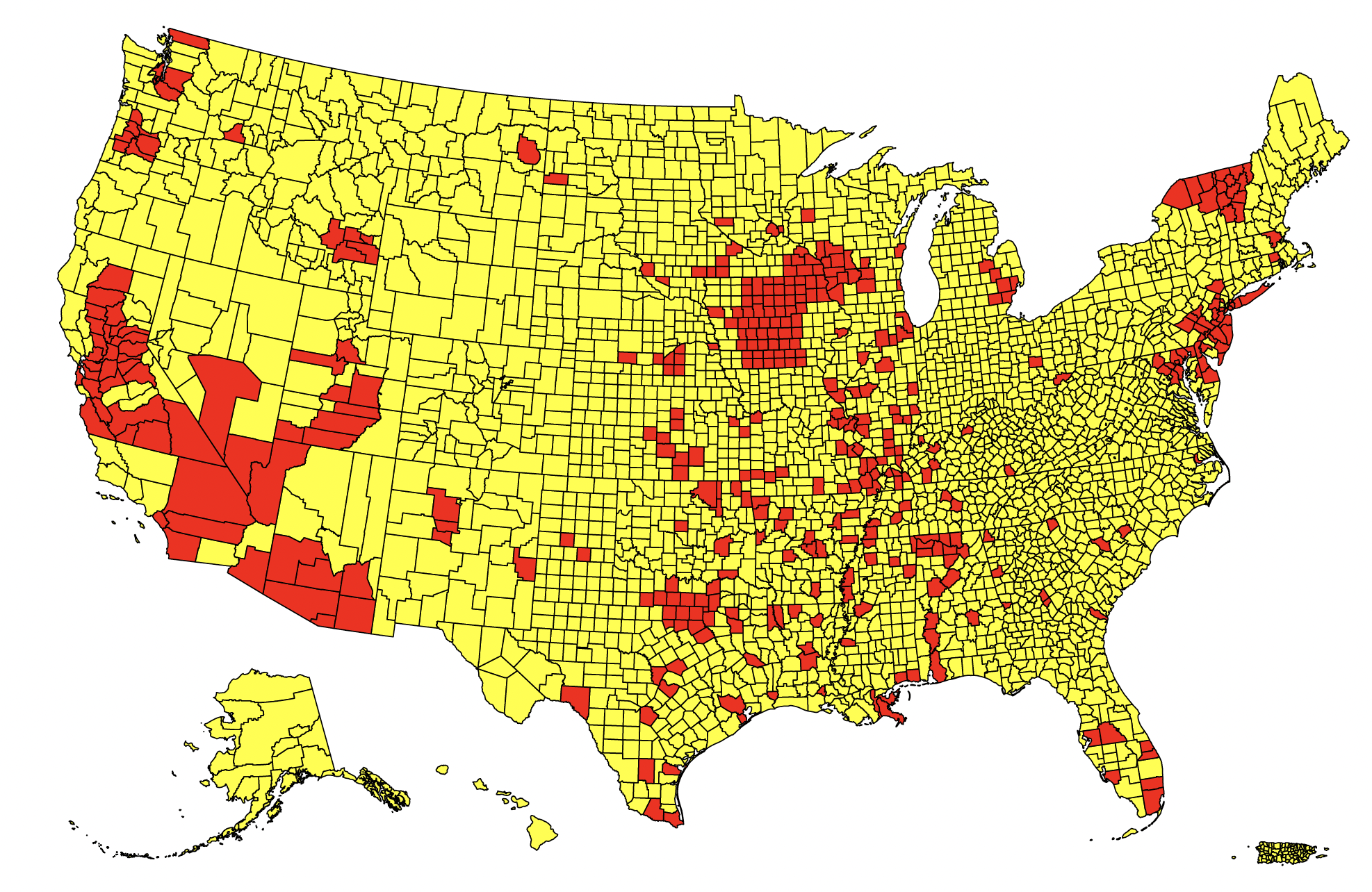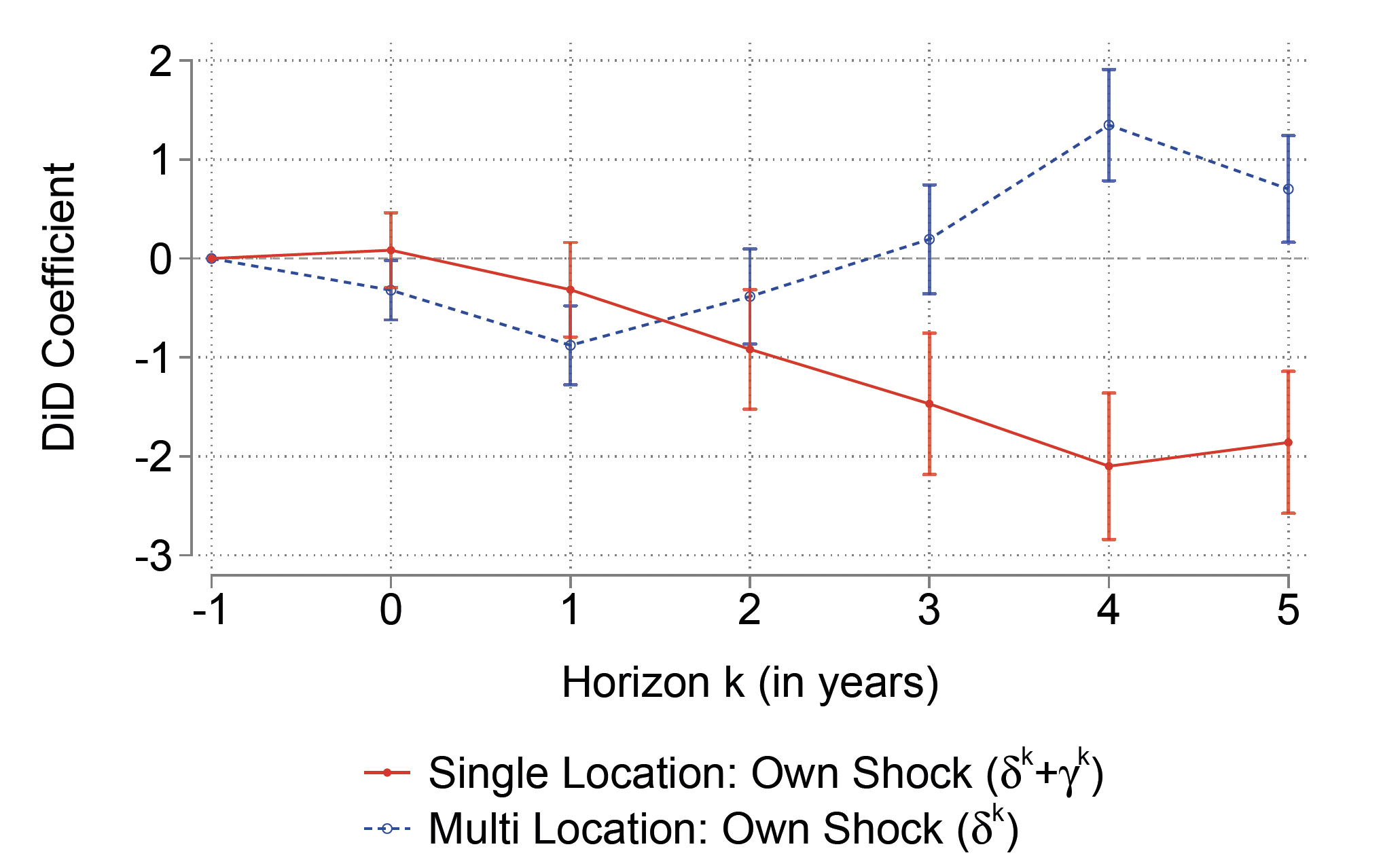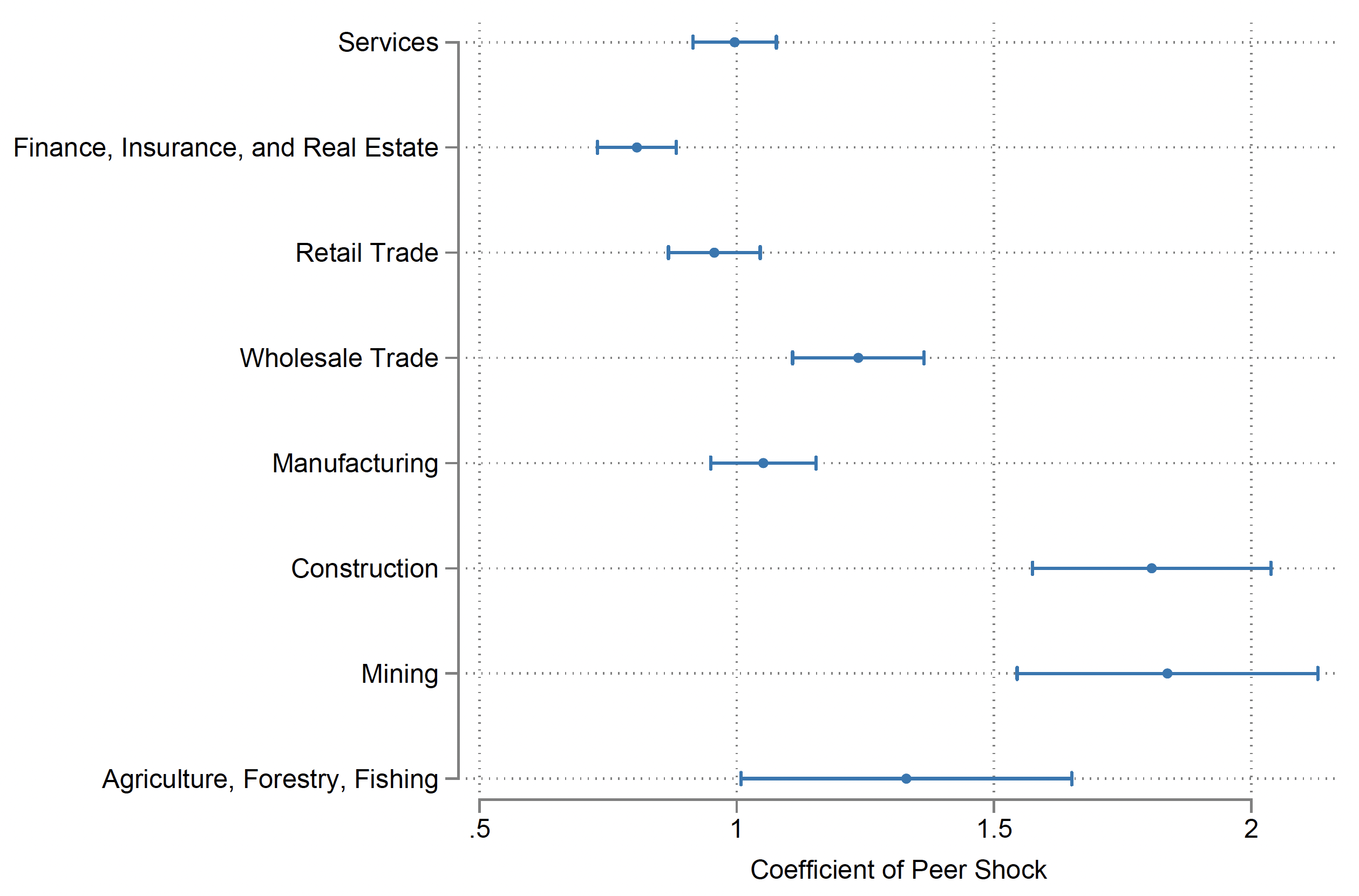Climate-related disasters are expected by many scientists to become increasingly frequent in the coming decades. Among the various facets of climate change, heat-related hazards are the leading cause of deaths in the US andaccount for the majority of projected damages due to climate change (Vaidyanathan et al. 2020, Hsiang et al. 2017). Historically, economies adapted to, and in turn mitigated the impact of such heat shocks on employment and economic activity by undertaking migration via inter-regional trade or informal diversification mechanisms (e.g. Gineet al. 2012, Baez et al. 2017).
In our recent paper (Acharya et al. 2023), we investigate whether modern corporations that organise employment across multiple establishments effectively act as ‘heat insulators’ for the economy. In particular, we ask whether multi-establishment firms mitigate heat exposure by reorganising employment and production spatially, what factors aid or impede such a response, and whether such a response leads to a spatial redistribution of economic activity.
Multi-location firms are more resilient to heat shocks
We tackle these questions by using establishment-level data from Dun & Bradstreet Global Archive Files (D&B) and disaster information from the Spatial Hazard Events and Losses Database for the United States (SHELDUS) over the period from 2009 to 2020. Figure 1 shows that locations across the US have experienced heat stress during our sample period. We find that while all firms generally reduce employment in the locations affected by a heat stress, multi-location firms increase employment at their unaffected establishments while single-location firms simply downsize. We calculate firms’ realised heat exposure as the employment-weighted-average of ‘hot days’ across all their locations, where a ‘hot day’ is defined as a day experiencing loss (property, crop, injury, or fatality) due to heat hazard according to the SHELDUS database.
Figure 1 Heat shocks across the US
Notes: Figure 1 shows the counties that experienced one or more hot days throughout our sample period of 2009 to 2020. Hot Days are days when a loss (property, crop, injury, or fatality) occurred from a heat hazard according to the SHELDUS database.
Figure 2 shows the relationship between firms’ heat exposure in year t and their employment growth from year t−1 to t+k. We find that while both single-location and multi-location firms experience an immediate decline in employment following heat exposure, multi-location firms suffer disproportionately less in the long run. For example, we find thatwhile one standard deviation increase in firm exposure lowers employment growth of single-location firms by 0.47% over three years, multi-location firms experience no such decline.
Figure 2 Impact of heat shocks: Single vs multi-location firms
Notes: Figure 2 shows the impact of heat shocks on single-location (red) and multi-location (blue) firms. The data is aggregated at the firm-year level. The coefficients on the Y-axis represent the impact of heat stress on the firm at time 0 on the employment growthover a k-year horizon.
Firms reallocate workers to unaffected peer counties and enter new locations less exposed to heat stress
Having a diversified geographical presence benefits the firms in two ways. First, it lowers the chances of all their sites facing a heat wave at once. Second, it enables them to reallocate workforce across regions with varying exposure to climate shocks.
To examine workforce reallocation within the firms’ establishment network, we calculate a ‘peer shock’ measure foreach establishment as the total number of hot days (scaled by their relative employment) that its sister establishments (i.e. those of the same firm) experienced in a given year. Our empirical strategy then compares the employment growth in two establishments in the same county-year that are exposed to different shocks in other regions due to differences in firms’ establishment networks. This specification allows us to control for any time-varying local economic shocks that may affect local employment growth. We find that a 1% increase in peer shock measure is associated with a 1% increase in establishments’ employment growth over three years.
To gauge the economic magnitude of these results, consider a firm with two equal-sized establishments in separate counties. Our results suggest that a hot day in one location is associated with a 0.7% increase in employment growth in the other establishment. We also find that the probability of the aforementioned firm to enter a new location increases by 0.07 percentage points, and this response in stronger in new locations that are less exposed to heat stress. These results suggests that firms respond to heat shocks by reallocating resources from affected areas to less affected ones.
Reallocation depends on firm and location characteristics
Firms may need significant resources to reorganise their geographical presence and hedge climate risk, as it requires expanding production capacity and training new staff at unaffected locations. However, with costly external financing, firms may face a trade-off between spending on climate risk management and thereby building resiliency versus maintaining cash buffers to avoid financial distress (e.g. Acharya et al. 2021). This implies that financially constrained firms might struggle in pursuing the spatial mitigation strategy. Indeed, we find stronger response among larger, profitable firms with lower leverage and credit risk. These results indicate that while employment reallocation can dampen the adverse impact of heat shocks on aggregate employment, the associated costs are borne by firms.
We also find that employment reallocation is higher when investors are ESG-affiliated (Cohen et al. 2020) andperceive greater climate risk, as measured by earnings call transcripts (Sautner et al. 2023). These findings suggest that environment-oriented investors concerned about climate risk can help firms in combating climate change whereas financial constraints impede such a response.
Firm response is driven by heat impact on labour productivity
Heat shocks can adversely affect firms by raising their energy expenditures or by lowering their labour productivity, potentially exposing workers to injuries and fatalities. To understand the mechanism behind firms’ response, we explore heterogeneity across industry groups and find that industries where workers have significant outdoor exposure, e.g. mining and construction, exhibit the maximum amount of mitigation in our sample (Figure 3). Wealso find that industries most amenable to teleworking exhibit weaker mitigation activity. Collectively, our results suggest that the firms are relocating to minimise heat-related losses in labour productivity.
Figure 3 Mitigation across industries
Notes: Figure 3 shows the extent of mitigation across broadly defined industries. The plotted coefficients denote how heat shock at anestablishment affects the three-year employment growth at its peer locations.
Role of local factors
Understanding local factors that aid firm mitigation can help policymakers combat climate change more effectively. Therefore, we examine which counties are most appealing for firms looking to relocate their workforce in the wake of heat shocks. First, we find that consistent with firms mitigating their future climate change exposure, employment growth is stronger in unaffected counties with lower projected heat-related damage, as measured by estimates of Spatial Empirical Adaptive Global-to-Local Assessment System (SEAGLAS) by Hsiang et al. (2017).
Turning to economic factors, higher GDP growth and credit availability (as measured by per-capita bank loan originations) increase mitigation-driven employment growth. Finally, labour market competition, measured by lower employment concentration across firms (employment HHI) and weaker enforcement of non-compete agreements, also supports firms’ response. From a policy perspective, these results underline that enhancing credit access and fostering a competitive labour market can not only help local economies attract companies but also help policymakers leverage the support of the corporate sector in minimising the adverse consequences of rising temperatures.
Workforce reallocation as a long-term climate adaptation strategy
We next evaluate employment reallocation as a long-term mitigation strategy against the evolving nature of heat shocks. Heat waves are becoming longer and more acute over time. They are also increasingly compounded by other natural disasters like hurricanes and wildfires (Raymond et al. 2022). Relatedly, communities experiencing chronic heat conditions historically may have responded on their own, reducing the need for firms to step in. We find that mitigation response is higher after more acute heat hazards – those causing non-zero property damage. Firms also respond more strongly against heat shocks in chronically affected counties defined as those with higher historical incidences of heat shocks. We also find that response to heat shocks is stronger when they are accompanied by other disasters (Figure 4). These results underscore the importance of firm-driven climate mitigation policies for their long-term productivity.
Figure 4 Other climate hazards
Notes: Figure 4 shows firm mitigation in response to different types of climate disasters. The plotted coefficients denote how heatshocks (stand-alone and when accompanied by other disasters) at an establishment affects k-year employment growth at its peer locations.
Impact on aggregate economic outcomes
These firm decisions on where to allocate employment have broader geographical consequences. Collectively, our results imply that while counties experiencing heat shocks could lose employment, other counties connected to them via firm networks should see their employment rise. We find that counties experience a significant increase in employment after other counties associated with them through firm networks face heat shocks (Figure 5). We also find that such counties experience an increase in the number of establishments operating within their boundaries. Overall, our results indicate that firms’ mitigation activity creates a positive spillover effect of heat shocks in a county on peer counties’ employment and number of establishments.
Figure 5 County-level results on changes in log employment
Notes: Figure 5 shows outcomes in a county after heat shocks hit it and its peer counties. The data is aggregated at thecounty-year level. Own shock is the number of hot days in the county, and peer shock is the establishment-network-weighted number of hot days in other counties. These estimates employ county and year fixed effects to absorb cross-sectional and aggregate differences.
References
Acharya, V V, H Almeida, Y Amihud and P Liu (2021), “Efficiency or resiliency? Corporate choice between financial and operational hedging”, Working Paper.
Acharya, V V, A Bhardwaj and T Tomunen (2023), “Do firms mitigate climate impact on employment? Evidence from US heat shocks”, NBER Working Paper 31967.
Baez, J, G Caruso, V Mueller and C Niu (2017), “Heat exposure and youth migration in Central America and the Caribbean”, American Economic Review 107(5): 446–450.
Cohen, L, U G Gurun and Q H Nguyen (2020), “The ESG-innovation disconnect: Evidence from green patenting”, NBER Working Paper 27990.
Gin´e, X, L Menand, R Townsend and J Vickery (2012), “Microinsurance: A case study of the Indian rainfall index insurance market”, Handbook of the Indian Economy,167–94.
Hsiang, S, R Kopp, A Jina, J Rising, M Delgado, S Mohan, D Rasmussen, R MuirWood, P Wilson, M Oppenheimer, et al. (2017), “Estimating economic damage from climate change in the United States”, Science 356(6345): 1362–1369.
Raymond, C, L Suarez-Gutierrez, K Kornhuber, M Pascolini-Campbell, J Sillmann and D E Waliser (2022),“Increasing spatiotemporal proximity of heat and precipitation extremes in a warming world quantified by a largemodel ensemble”, Environmental Research Letters 17(3), 035005.
Sautner, Z, L Van Lent, G Vilkov and R Zhang (2023), “Firm-level climate change exposure”, The Journal of Finance 78(3): 1449–1498.
Vaidyanathan, A, J Malilay, P Schramm and S Saha (2020), “Heat-related deaths—United States, 2004–2018”, Morbidity and Mortality Weekly Report 69(24): 729.










